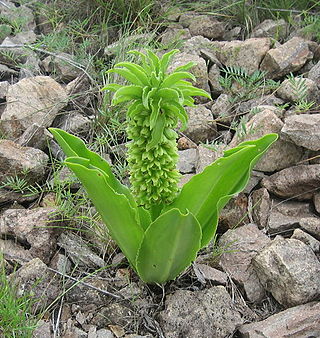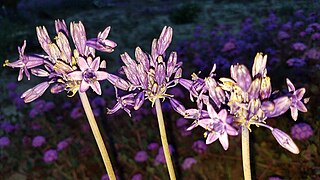
Pleurothallis is a genus of orchids commonly called bonnet orchids. The genus name is derived from the Greek word pleurothallos, meaning "riblike branches". This refers to the rib-like stems of many species. The genus is often abbreviated as "Pths" in horticultural trade.

Scilla is a genus of about 30 to 80 species of bulb-forming perennial herbaceous plants in the family Asparagaceae, subfamily Scilloideae. Sometimes called the squills in English, they are native to woodlands, subalpine meadows, and seashores throughout Europe, Africa and the Middle East. A few species are also naturalized in Australasia and North America. Their flowers are usually blue, but white, pink, and purple types are known; most flower in early spring, but a few are autumn-flowering. Several Scilla species are valued as ornamental garden plants.

Hesperocyparis arizonica, the Arizona cypress, is a North American species of tree in the cypress family Cupressaceae, native to the southwestern United States and Mexico. Populations may be scattered rather than in large, dense stands.

Selenicereus, sometimes known as moonlight cactus, is a genus of epiphytic, lithophytic, and terrestrial cacti, found in Mexico, Central America, the Caribbean and northern South America. The term night-blooming cereus is also sometimes used, but this is also used for many night-blooming cacti, including Epiphyllum and Peniocereus. In 2017, the genus Hylocereus was brought into synonymy with Selenicereus. A number of species of Selenicereus produce fruit that is eaten. The fruit, known as pitaya or pitahaya in Spanish or as dragon fruit, may be collected from the wild or the plants may be cultivated.

Lomandra, commonly known as mat rushes, is a genus of perennial, herbaceous monocots in the family Asparagaceae, subfamily Lomandroideae. There are 51 species, all of which are native to Australia; two of them also extend into New Guinea and New Caledonia.

Asparagaceae, known as the asparagus family, is a family of flowering plants, placed in the order Asparagales of the monocots. The family name is based on the edible garden asparagus, Asparagus officinalis. This family includes both common garden plants as well as common houseplants. The garden plants include asparagus, yucca, bluebell, and hosta, and the houseplants include snake plant, corn cane, spider plant, and plumosus fern.

Beaucarnea is a genus of flowering plants native to Mexico and Central America. In the APG III classification system, it is placed in the family Asparagaceae, subfamily Nolinoideae. Beaucarnea is sometimes treated as a synonym of the genus Nolina, with the species being then transferred to that genus. However, recent research shows that Beaucarnea should be treated as an independent genus.

Aphyllanthes is a genus of flowering plants with only one species, Aphyllanthes monspeliensis, endemic to the western Mediterranean region. It is the only genus in the Aphyllanthoideae, a subfamily of the family Asparagaceae. Aphyllanthoideae was formerly treated as a separate family, Aphyllanthaceae.

Eucomis is a genus of flowering plants in the family Asparagaceae, subfamily Scilloideae, native to southern Africa. Most species of this genus are commonly referred to as pineapple flowers or pineapple lilies. They are bulbous perennials with basal rosettes of leaves and stout stems covered in star-shaped flowers with a tuft of green bracts at the top, superficially resembling a pineapple – hence the common names.
Harold Emery Moore, Jr. was an American botanist especially known for his work on the systematics of the palm family. He served as Director of the L. H. Bailey Hortorium at Cornell University, and was appointed Liberty Hyde Bailey Professor of Botany in 1978. He was an important contributor to Hortus Third and was editor of Principes, the journal of the International Palm Society. He also edited Gentes Herbarum and provided the foundation for the first edition of Genera Palmarum, a seminal work on palm taxonomy which was later completed by Natalie Uhl and John Dransfield.
Xylothamia, the desert goldenrods, is a formerly accepted genus of flowering plants in the family Asteraceae. Until 2003, it was held to contain nine species of shrubs native to the deserts of Mexico and the southwestern United States. As of May 2024, Plants of the World Online divided the nine former species of Xylothamia among Aquilula, Gundlachia, and Medranoa.
James Edgar Dandy was a British botanist, Keeper of Botany at the British Museum between 1956 and 1966. He was a world specialist on the plant genus Potamogeton and the family Magnoliaceae.

Hemiphylacus is a genus of flowering plants endemic to Mexico. In the APG III classification system, it is placed in the family Asparagaceae, subfamily Asparagoideae.

Petronymphe is a genus of flowering plants endemic to Mexico. It is placed in the family Asparagaceae, subfamily Brodiaeoideae.

Triteleiopsis, common name Bajalily or blue sand lily, is a genus of one known species of flowering plant found in Sonora, Baja California and southwestern Arizona. In the APG III classification system, it is placed in the family Asparagaceae, subfamily Brodiaeoideae.

Speirantha is a genus of one known species of flowering plants found in south-east China. In the APG III classification system, it is placed in the family Asparagaceae, subfamily Nolinoideae.

Tupistra is a genus of about 20 species of flowering plants found in south Asia, from southern China to Sumatra and Ambon Island. In the APG III classification system, it is placed in the family Asparagaceae, subfamily Nolinoideae.

Xochiquetzallia is a genus of geophytic flowering plants of the subfamily Brodiaeoideae in the family Asparagaceae. The genus contains four species: three previously classified within the genus Dandya and one other previously classified within Milla. Earlier genetic and morphological research had shown that the broad Milla clade of plants is made up of two sister lineages. The four plant species now within Xochiquetzallia make up one of these lineages, and are more closely related to each other than they are to the second lineage, which is made up of the remaining Milla species, Dandya purpusii, and the genera Behria, Bessera, Jaimehintonia and Petronymphe. Jorge Gutiérrez and Teresa Terrazas, two of the botanists who worked on the earlier research, followed up in 2020 with a paper formally transferring the four species from Dandya and Milla to Xochiquetzallia.
Beaucarnea purpusii is a tree in the family Asparagaceae, native to Mexico. It grows up to 8 metres (30 ft) tall.
Medranoa is a genus of flowering plant in the family Asteraceae, native to northeastern Mexico and Texas. The genus was established in 2004, initially with a single species. It was expanded to five species in 2007, incorporating species formerly placed in Xylothamia, and then in Chihuahuana, Neonesomia, and Xylovirgata.














